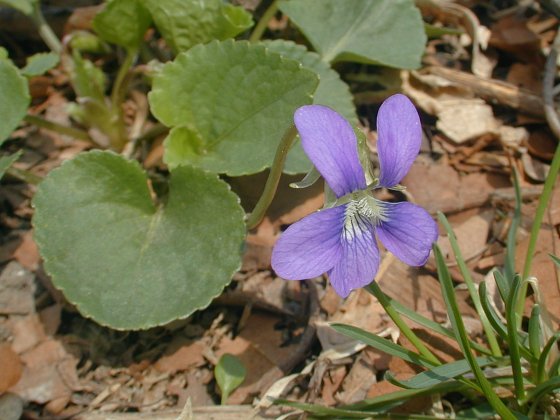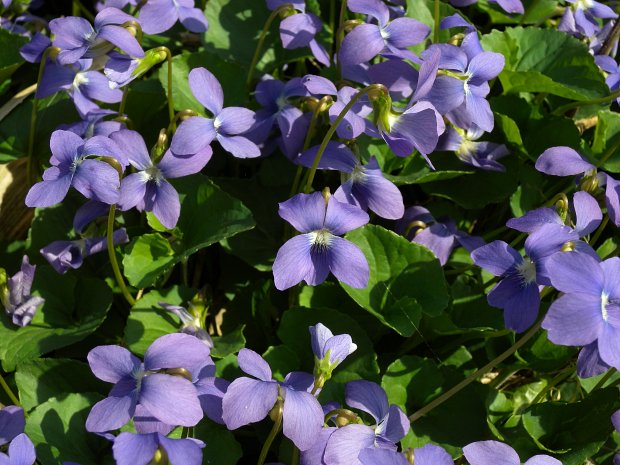Description: This is a herbaceous perennial plant with the leaves and flowers emerging directly from the rhizomes, and forming a basal rosette. A typical mature plant may be 6" across and 4" high, with the flowers slightly higher than the leaves. The leaves are individually up to 3" long and 3" across (excluding the long petioles), and vary in color from yellowish green to dark green, depending on growing conditions. They are oval-ovate to orbicular-cordate in shape, and crenate or serrate along the margins. Different populations of plants can vary in the hairiness of their leaves – from nearly glabrous to conspicuously hairy or pubescent. The flowers are about ¾" across, and consist of 5 rounded petals. There are 2 upper petals, 2 lateral petals with white hairs (or beards) near the throat of the flower, and a lower petal that functions as a landing pad for visiting insects. The flowers of this form of Viola sororia are medium to dark violet. The inner throat of each flower is more or less white, from which slightly darker veins radiate outward along the petals (particularly the lower one). There is no noticeable floral scent. The blooming period occurs from mid- to late spring, and lasts about 1-1½ months. During the summer, cleistogamous flowers without petals produce seeds, which are flung outward by mechanical ejection from the three-parted seed capsules. The root system consists of thick, horizontally branched rhizomes; there is a tendency to form vegetative colonies.

Cultivation:
The
preference is partial sun or light shade, and moist to average
conditions, although full sun is tolerated if there is sufficient
moisture. The soil should be a rich silty loam or clay loam with above
average amounts of organic matter. The leaves have a tendency to turn
yellowish green when exposed to full sun under dry conditions – this
reaction is normal, and is not necessarily a sign of poor health. This
plant is very easy to grow, and it will spread under favorable
conditions. This wildflower will adapt to lawns, especially if they are
not mowed too often during the spring or cut too low.
Habitat & Range:
The native Common Blue Violet occurs in every county in Illinois and it
is
very common (see Distribution
Map). Natural habitats include moist to mesic black soil
prairies, open woodlands, woodland edges, savannas, and wooded slopes
along rivers or lakes. In developed areas, it can be found in lawns,
city parks, moist waste areas, and along hedges or buildings. Sometimes
the Common Blue Violet is grown in flower gardens.
 auto; max-width: 100%
auto; max-width: 100%
Faunal
Associations:
The flowers are not often visited by insects (hence the need for
cleistogamous flowers), but sometimes they attract bees (e.g., Mason,
Halictid), skippers, Syrphid flies, and other insects. The Syrphid
flies, however, feed only on stray pollen and are non-pollinating. The
caterpillars of many Fritillary butterflies feed on the foliage,
including Speyeria diane (Diana), Euptoieta
claudia (Variegated Fritillary), Speyeria
aphrodite (Aphrodite Fritillary), Boloria bellona
(Meadow Fritillary), and Boloria selene myrina
(Silver-Border Fritillary). The seeds have soft appendages that attract
ants, which are in part distributed by them. Various upland gamebirds
and small mammals occasionally eat the seeds, including the Wild
Turkey, Bobwhite, Mourning Dove, and White-Footed Mouse. Wild Turkeys
also eat the leaves and fleshy roots of Viola spp. (Violets).
Although it is not a preferred food source, mammalian herbivores
occasionally eat the foliage of violets, including the White-Tailed
Deer, Cottontail Rabbit, and livestock.
Photographic Location:
The photographs were taken at the webmaster's wildflower
garden in Urbana, Illinois, Crystal Lake Park of the same city, and at
the edge of an agricultural field outside of the same city in Champaign
County, Illinois.

Comments: The flowers and young leaves of violets are edible, and can be added to salads in small amounts. The taste is bland. This is the most common Viola sp. (Violet) in Illinois. There are several forms of Viola sororia with differently colored flowers; these often grow in close proximity to each other in a given area. The typical form that is described here, f. sororia, has medium to dark violet flowers and rather well-rounded leaves. Some authorities (e.g., Mohlenbrock) consider these different color forms to be separate species, but this does not seem appropriate to me. Some authorities also consider pubescent and non-pubescent specimens of Common Blue Violet to be separate species, but they tend to intergrade in the field, possibly in response to levels of sunlight in a given habitat. However, if this taxonomic distinction is accepted, then non-pubescent specimens can be referred to as Viola pratincola (Common Blue Violet), while pubescent specimens can be referred to as Viola sororia (Woolly Blue Violet). Because the plants in the above photographs are non-pubescent, they would be considered specimens of Viola pratincola according to this taxonomy.